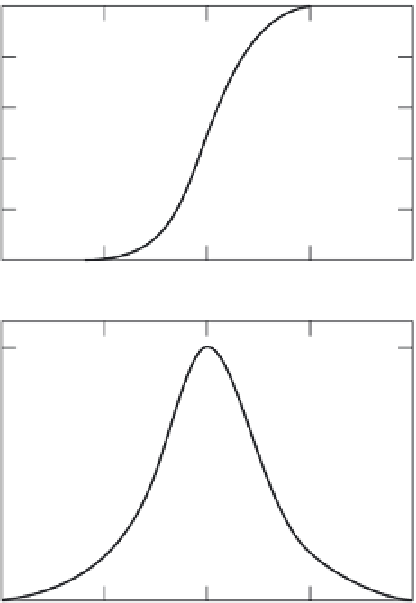Geoscience Reference
In-Depth Information
c
∞
The phase velocity is approximately given by
c
0
1
)
2
(
ωτ
)
2
c
(w)
Q
−
max
c
(
ω
)
=
+
(2)
1
+
(
ωτ
where
c
0
is the zero-frequency velocity. The high-
frequency or elastic velocity is
c
∞
=
c
0
1
+
Q
−
max
(3)
Far away from the absorption peak, the velocity
can be written
c
(
ω
)
≈
c
0
1
+
c
0
k
2
Q
−
2
Q
−
1
1
2
k
1
for
ωτ
1
1
−
k
2
)
k
2
Q
−
2
k
1
(2
k
1
+
=
c
∞
for
ωτ
1
and the
Q
effect is only second order. In these lim-
its, velocity is nearly independent of frequency,
but
Q
is not;
Q
and
c
cannot both be inde-
pendent of frequency. Velocity depends on the
attenuation. When
Q
is constant, or nearly so,
the fractional change in phase velocity becomes
a first-order effect.
For activated processes,
0
0.01
0.1
1
10
100
w
τ
Fig. 19.1
Q
−
1
and phase velocity as a function of frequency
for a standard linear solid with a single relation time.
τ
=
τ
0
exp
E
∗
/
RT
(4)
where
E
∗
is an activation energy. This is where
the temperature dependence of seismic velocities
comes in, in anelastic processes. Velocity is not a
simple linear function of temperature.
For activated processes, then,
the temperature dependence of moduli or seis-
mic velocities.
The
Q
−
1
of such a system is
k
2
k
t
ωτ
1
+
(
ωτ
)
2
Q
−
1
(
ω
=
)
Q
−
1
(
ω
=
2
Q
−
max
{
ωτ
0
exp
E
∗
/
}
/
{
+
ωτ
0
)
2
)
RT
1
(
where k
2
and k
1
are, respectively, the spring
constants (or moduli) of the series spring and
the
exp 2
E
∗
/
×
}
RT
(5)
parallel
spring
and
τ
is
the
relaxation
The relaxation peak can be defined either by
changing
ω
or changing
T
.
At high temperatures, or low frequencies,
time.
Clearly,
Q
−
1
, the dimensionless attenuation,
is a maximum at
ωτ
=
1, and
Q
−
1
(
ω
)
=
2
Q
−
max
ωτ
0
exp
E
∗
/
RT
(6)
ωτ
1
+
(
ωτ
)
2
Q
−
1
(
2
Q
−
max
ω
)
=
(1)
This is contrary to the general intuition that
attenuation
must
increase
with
temperature.
The resulting absorption peak is shown in
Figure 19.1. This can be considered a plot of atten-
uation and velocity vs. either frequency, or tem-
perature, since
However, if
differs greatly from seismic peri-
ods, it is possible that we may be on the low-
temperature
τ
or
high-frequency
portion
of
the
τ
is a function of temperature,
an exponential function for thermally activated
processes.
absorption peak, and
Q
−
1
(
2
Q
−
max
/
ωτ
0
exp
E
∗
/
ω
)
=
(
RT
)
,ωτ
1
(7)













